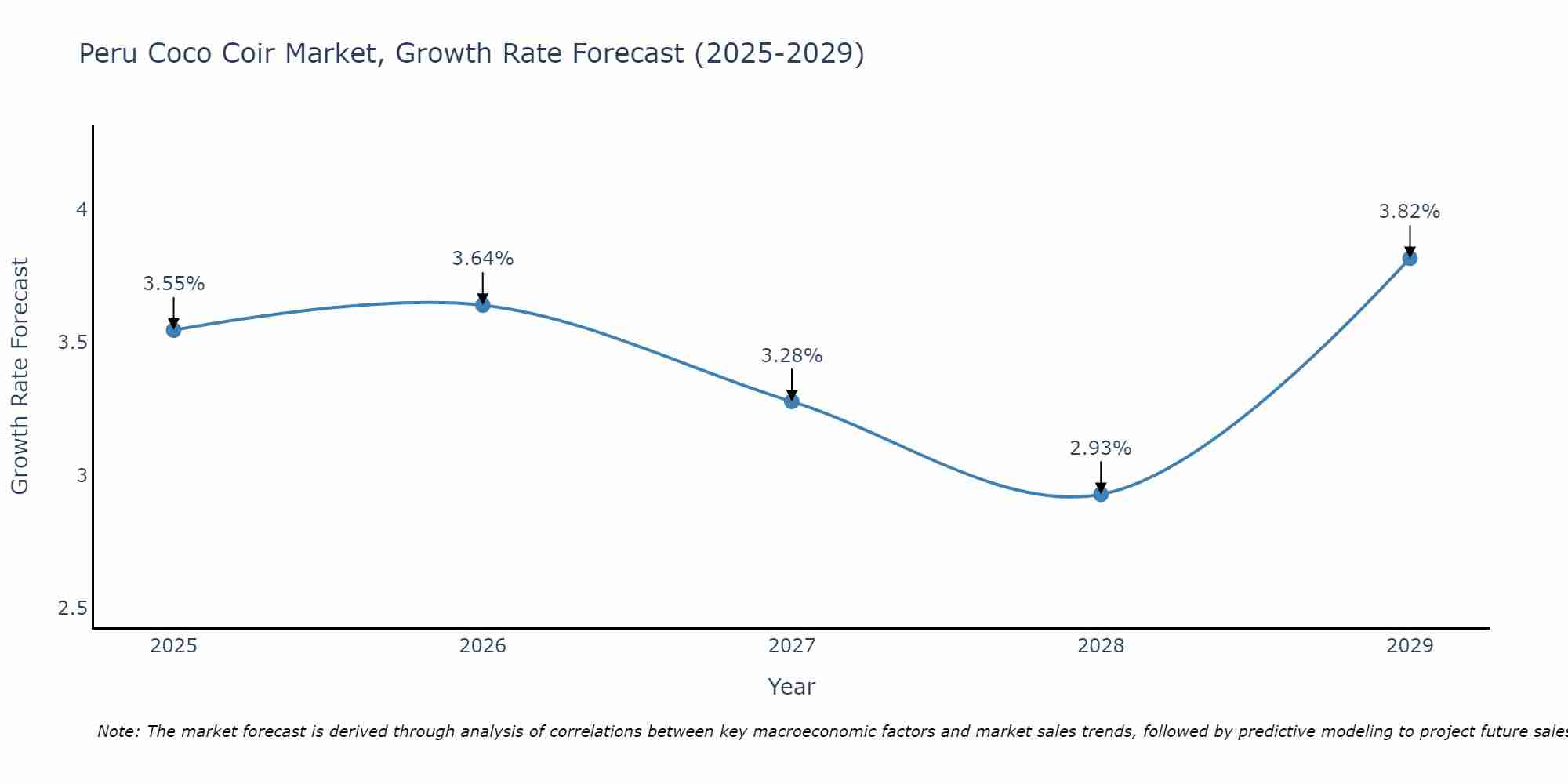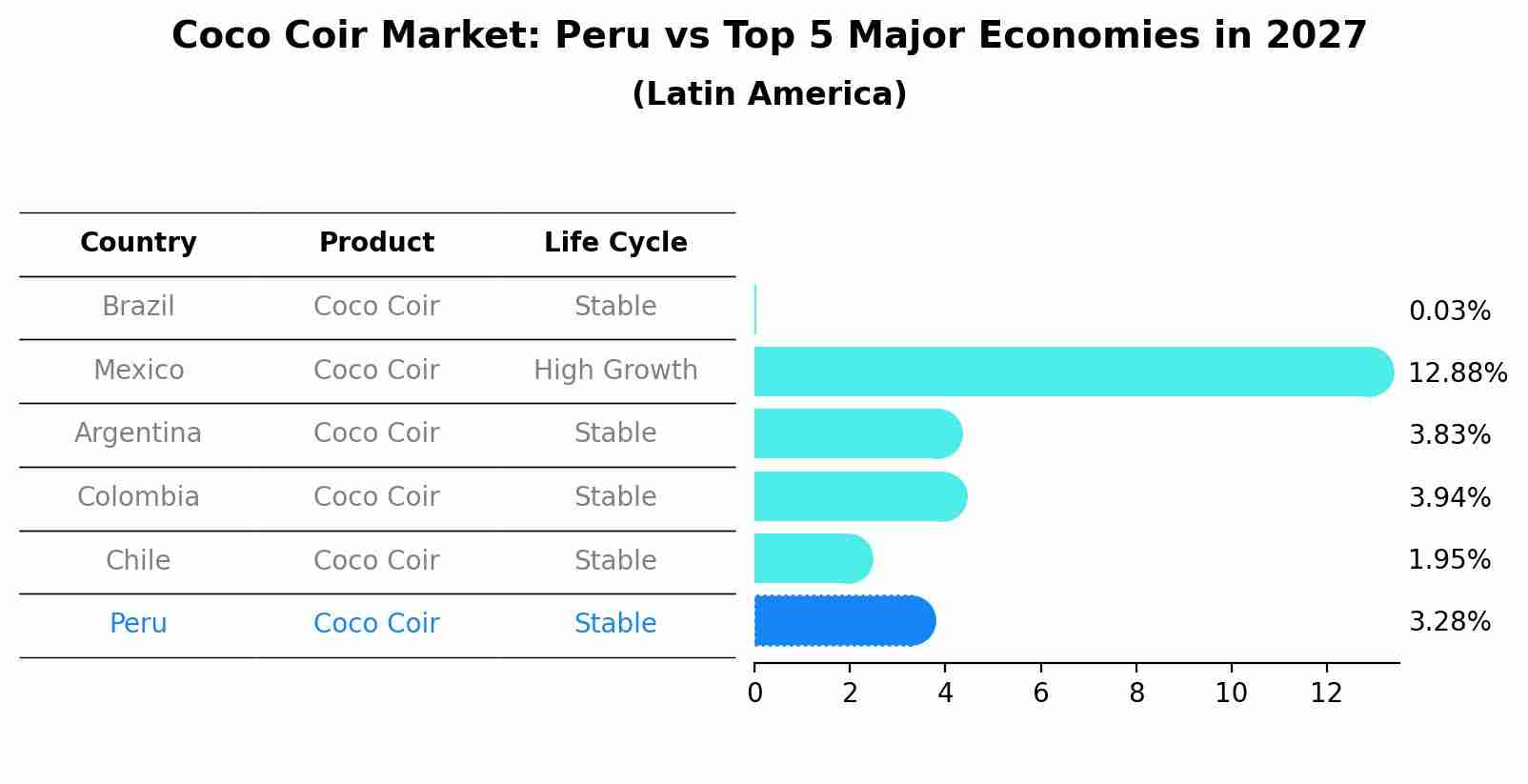Peru Coco Coir Market (2025-2031) Outlook | Forecast, Size, Value, Analysis, Share, Growth, Revenue, Industry, Trends & Companies
| Product Code: ETC373686 | Publication Date: Aug 2022 | Updated Date: Jul 2025 | Product Type: Market Research Report | |
| Publisher: 6Wresearch | Author: Ravi Bhandari | No. of Pages: 75 | No. of Figures: 35 | No. of Tables: 20 |
Peru Coco Coir Market Size Growth Rate
The Peru Coco Coir Market is projected to witness mixed growth rate patterns during 2025 to 2029. From 3.55% in 2025, the growth rate steadily ascends to 3.82% in 2029.

Coco Coir Market: Peru vs Top 5 Major Economies in 2027 (Latin America)
The Coco Coir market in Peru is projected to grow at a stable growth rate of 3.28% by 2027, highlighting the country's increasing focus on advanced technologies within the Latin America region, where Brazil holds the dominant position, followed closely by Mexico, Argentina, Colombia and Chile, shaping overall regional demand.

Peru Coco Coir Market Synopsis
The Peru Coco Coir Market is witnessing steady growth driven by increasing demand for sustainable and environmentally friendly growing mediums in the agriculture and horticulture sectors. Coco coir, derived from coconut husks, is valued for its water retention properties, aeration, and ability to improve soil quality. The market is benefiting from the rising adoption of organic farming practices and the shift towards alternative growing substrates that reduce environmental impact. Key players in the Peru Coco Coir Market are focusing on product innovation, expanding distribution networks, and strategic partnerships to capitalize on the growing demand. Government initiatives promoting sustainable agriculture practices further support market growth. Overall, the Peru Coco Coir Market is poised for continued expansion in the coming years as awareness of its benefits continues to rise among farmers and growers.
Peru Coco Coir Market Trends
The Peru Coco Coir Market is experiencing a significant growth trend driven by the increasing demand for sustainable and eco-friendly growing mediums in agriculture and horticulture. Coco coir, made from coconut husks, is gaining popularity as a renewable alternative to traditional peat moss due to its superior water retention and aeration properties. The market is witnessing a rise in the adoption of coco coir products for hydroponic farming, greenhouse cultivation, and landscaping applications. Additionally, the growing awareness among consumers about the benefits of using organic and biodegradable materials is further fueling the market growth. Key players in the Peru Coco Coir Market are focusing on product innovations, expanding their distribution networks, and collaborating with local farmers to ensure a stable supply chain, driving the overall market expansion.
Peru Coco Coir Market Challenges
In the Peru Coco Coir market, some challenges faced include limited awareness among farmers about the benefits of using coco coir as a growing medium, competition from traditional soil-based products, and the high initial investment required for transitioning to coco coir. Additionally, issues related to the quality and consistency of coco coir products, such as variations in pH levels and salt content, can also pose challenges for growers. Lack of standardized regulations and certifications in the industry further hinders market growth and consumer trust. Overcoming these challenges will require educating farmers about the advantages of coco coir, improving product quality control measures, and establishing industry standards to ensure consistency and quality across the market.
Peru Coco Coir Market Investment Opportunities
The Peru Coco Coir Market presents promising investment opportunities due to the increasing global demand for sustainable and organic growing mediums. Coco coir, made from coconut husks, is gaining popularity in the agriculture and horticulture industries for its eco-friendly properties and excellent water retention capabilities. Investing in the Peru Coco Coir Market can be lucrative as the country is a major producer of coconuts, providing a reliable source of raw materials. Additionally, Peru`s strategic location offers easy access to international markets, enhancing export potential. With growing awareness of environmental issues and a shift towards organic farming practices, investing in the Peru Coco Coir Market can offer long-term growth prospects and a sustainable investment option.
Jordan Agar Market Government Policies
The Peruvian government has implemented various policies to support the Coco Coir Market. This includes providing financial incentives, such as tax breaks and subsidies, to encourage the production and export of coco coir products. Additionally, there are regulations in place to ensure sustainable harvesting practices and environmental conservation. The government also supports research and development initiatives to improve the quality and productivity of coco coir production in Peru. Overall, these policies aim to promote the growth of the coco coir industry, create employment opportunities, and boost the country`s economy through increased exports of coco coir products.
Peru Coco Coir Market Future Outlook
The Peru Coco Coir market is poised for significant growth in the coming years due to the rising demand for sustainable and organic farming practices. As consumers become more environmentally conscious, there is a growing preference for coco coir as a natural and renewable alternative to traditional soil. The versatile applications of coco coir in horticulture, agriculture, and landscaping further contribute to its increasing popularity. Additionally, the government`s support for the agricultural sector and initiatives promoting organic farming practices will drive the market expansion. With an emphasis on eco-friendly solutions and the benefits of coco coir such as water retention, aeration, and disease resistance, the Peru Coco Coir market is expected to witness steady growth and attract investments from both domestic and international players.
Key Highlights of the Report:
- Peru Coco Coir Market Outlook
- Market Size of Peru Coco Coir Market, 2024
- Forecast of Peru Coco Coir Market, 2031
- Historical Data and Forecast of Peru Coco Coir Revenues & Volume for the Period 2021 - 2031
- Peru Coco Coir Market Trend Evolution
- Peru Coco Coir Market Drivers and Challenges
- Peru Coco Coir Price Trends
- Peru Coco Coir Porter's Five Forces
- Peru Coco Coir Industry Life Cycle
- Historical Data and Forecast of Peru Coco Coir Market Revenues & Volume By Product for the Period 2021 - 2031
- Historical Data and Forecast of Peru Coco Coir Market Revenues & Volume By Coco Coir Grow Bags for the Period 2021 - 2031
- Historical Data and Forecast of Peru Coco Coir Market Revenues & Volume By Bales for the Period 2021 - 2031
- Historical Data and Forecast of Peru Coco Coir Market Revenues & Volume By Coir Material for the Period 2021 - 2031
- Historical Data and Forecast of Peru Coco Coir Market Revenues & Volume By Open Tops for the Period 2021 - 2031
- Historical Data and Forecast of Peru Coco Coir Market Revenues & Volume By Blends & Loose Substrate for the Period 2021 - 2031
- Historical Data and Forecast of Peru Coco Coir Market Revenues & Volume By Others for the Period 2021 - 2031
- Historical Data and Forecast of Peru Coco Coir Market Revenues & Volume By Application for the Period 2021 - 2031
- Historical Data and Forecast of Peru Coco Coir Market Revenues & Volume By Rope & Cordage for the Period 2021 - 2031
- Historical Data and Forecast of Peru Coco Coir Market Revenues & Volume By Coco Nets & Twines for the Period 2021 - 2031
- Historical Data and Forecast of Peru Coco Coir Market Revenues & Volume By Stitched Mats for the Period 2021 - 2031
- Historical Data and Forecast of Peru Coco Coir Market Revenues & Volume By Coconut Meals for the Period 2021 - 2031
- Historical Data and Forecast of Peru Coco Coir Market Revenues & Volume By Husk for the Period 2021 - 2031
- Historical Data and Forecast of Peru Coco Coir Market Revenues & Volume By Others for the Period 2021 - 2031
- Historical Data and Forecast of Peru Coco Coir Market Revenues & Volume By Consumer for the Period 2021 - 2031
- Historical Data and Forecast of Peru Coco Coir Market Revenues & Volume By Green Houses for the Period 2021 - 2031
- Historical Data and Forecast of Peru Coco Coir Market Revenues & Volume By Sellers for the Period 2021 - 2031
- Peru Coco Coir Import Export Trade Statistics
- Market Opportunity Assessment By Product
- Market Opportunity Assessment By Application
- Market Opportunity Assessment By Consumer
- Peru Coco Coir Top Companies Market Share
- Peru Coco Coir Competitive Benchmarking By Technical and Operational Parameters
- Peru Coco Coir Company Profiles
- Peru Coco Coir Key Strategic Recommendations
Frequently Asked Questions About the Market Study (FAQs):
- Single User License$ 1,995
- Department License$ 2,400
- Site License$ 3,120
- Global License$ 3,795
Search
Thought Leadership and Analyst Meet
Our Clients
Related Reports
- Canada Oil and Gas Market (2026-2032) | Share, Segmentation, Value, Industry, Trends, Forecast, Analysis, Size & Revenue, Growth, Competitive Landscape, Outlook, Companies
- Germany Breakfast Food Market (2026-2032) | Industry, Share, Growth, Size, Companies, Value, Analysis, Revenue, Trends, Forecast & Outlook
- Australia Briquette Market (2025-2031) | Growth, Size, Revenue, Forecast, Analysis, Trends, Value, Share, Industry & Companies
- Vietnam System Integrator Market (2025-2031) | Size, Companies, Analysis, Industry, Value, Forecast, Growth, Trends, Revenue & Share
- ASEAN and Thailand Brain Health Supplements Market (2025-2031) | Strategy, Consumer Insights, Analysis, Investment Trends, Opportunities, Growth, Size, Share, Industry, Revenue, Segments, Value, Segmentation, Supply, Forecast, Restraints, Outlook, Competition, Drivers, Trends, Demand, Pricing Analysis, Competitive, Strategic Insights, Companies, Challenges
- ASEAN Bearings Market (2025-2031) | Strategy, Consumer Insights, Analysis, Investment Trends, Opportunities, Growth, Size, Share, Industry, Revenue, Segments, Value, Segmentation, Supply, Forecast, Restraints, Outlook, Competition, Drivers, Trends, Demand, Pricing Analysis, Competitive, Strategic Insights, Companies, Challenges
- Europe Flooring Market (2025-2031) | Outlook, Share, Industry, Trends, Forecast, Companies, Revenue, Size, Analysis, Growth & Value
- Saudi Arabia Manlift Market (2025-2031) | Outlook, Size, Growth, Trends, Companies, Industry, Revenue, Value, Share, Forecast & Analysis
- Uganda Excavator, Crane, and Wheel Loaders Market (2025-2031) | Strategy, Consumer Insights, Analysis, Investment Trends, Opportunities, Growth, Size, Share, Industry, Revenue, Segments, Value, Segmentation, Supply, Forecast, Restraints, Outlook, Competition, Drivers, Trends, Demand, Pricing Analysis, Competitive, Strategic Insights, Companies, Challenges
- Rwanda Excavator, Crane, and Wheel Loaders Market (2025-2031) | Strategy, Consumer Insights, Analysis, Investment Trends, Opportunities, Growth, Size, Share, Industry, Revenue, Segments, Value, Segmentation, Supply, Forecast, Restraints, Outlook, Competition, Drivers, Trends, Demand, Pricing Analysis, Competitive, Strategic Insights, Companies, Challenges
Industry Events and Analyst Meet
Whitepaper
- Middle East & Africa Commercial Security Market Click here to view more.
- Middle East & Africa Fire Safety Systems & Equipment Market Click here to view more.
- GCC Drone Market Click here to view more.
- Middle East Lighting Fixture Market Click here to view more.
- GCC Physical & Perimeter Security Market Click here to view more.
6WResearch In News
- Doha a strategic location for EV manufacturing hub: IPA Qatar
- Demand for luxury TVs surging in the GCC, says Samsung
- Empowering Growth: The Thriving Journey of Bangladesh’s Cable Industry
- Demand for luxury TVs surging in the GCC, says Samsung
- Video call with a traditional healer? Once unthinkable, it’s now common in South Africa
- Intelligent Buildings To Smooth GCC’s Path To Net Zero


















